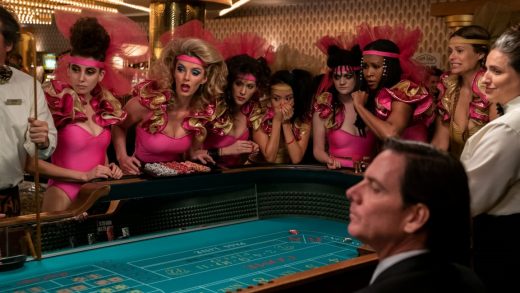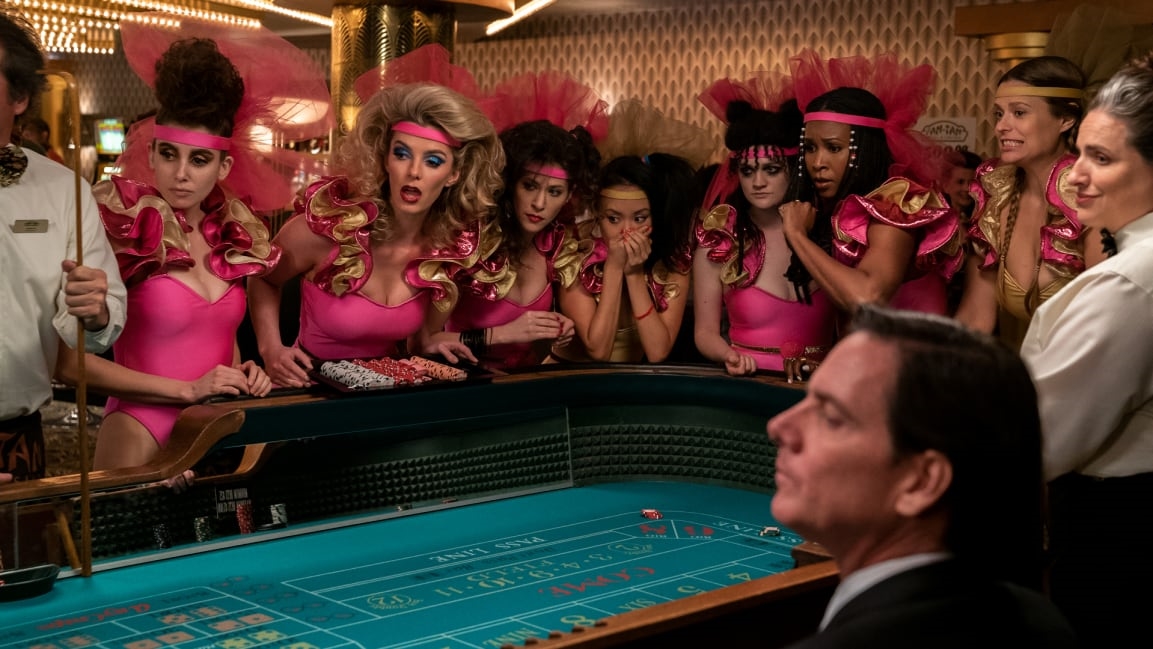The creators of Netflix’s ‘GLOW’ explain what you need to know before bingeing on season 3
The desert air in Las Vegas is infused with the stench of desperation and horniness. A lot has changed about the city over the years, but not that. It’s a perennial sleepless scrum of degenerate gamblers, unfaithful partners, illicit substances, and wacky bachelor/ette parties—all of it meant to be ephemeral. Las Vegas ensnares people, has its way with them, and then expels them back into the real world, almost always minus some money, brain cells, and dignity. Locals are both born and made, but mostly there’s just residencies. Staying within the artificially glitzy, greedy gaping maw of a hotel-casino for more than a few days is generally a roadmap for madness.
All of the elements that makes this city feel uniquely like some horrible trap, however, are just part of why the creators of Netflix’s hit comedy GLOW, Liz Flahive and Carly Mensch, decided to set the show’s entire third season in Vegas. There’s more to the story than that, though.
“Vegas makes us incredibly uncomfortable, in terms of the objectification of women, and gambling, and just how artificial everything feels,” Mensch says. “It also felt like a place where if you had to live there and perform a lot, it might be a good place for multiple existential crises to bubble up.”
Long before its relocation, the Los Angeles-set show arrived in the summer of 2017 with the imprimatur of producer Jenji Kohan (Orange Is the New Black) and a sprawling, combustible cast led by Alison Brie, Betty Gilpin, and Marc Maron. Set in the world of the real-life, short-lived Gorgeous Ladies of Wrestling show from the ’80s, GLOW quickly developed a fervent following for its sharp writing, balance of comedy and heart, panache, and pile-drivers. Several Emmy nominations followed. With its just-released third season, though, the character-rich show has now fully come into its own?—even as it moves into unfamiliar territory.
The first season established how the broken friendship of Ruth (Brie) and Debbie (Gilpin) anchored the wrestling show-within-a-show’s face–heel dynamic, while the other members of the team also found their grooves. In season two, our fictional version of the show has become a minor hit, but faces threats from within and without, ultimately losing its perch on TV. As a silver lining, though, the second season ends with the team signing on for a three-month stint performing in Las Vegas, which is right where the action picks up—and stays—for the third season.
“We knew from the beginning that we would be spending the whole season there,” Flahive says. “We didn’t know everything we were going to do, but we knew that we weren’t playing a game of, like, you’re there for two episodes, and then back to L.A. We really wanted to do a Vegas season, and we were very clear about that when we pitched Netflix at the end of season two.”
On the eve of the new batch of episodes dropping, creators and writers Flahive and Mensch walked Fast Company through all the reasons why Sin City made an irresistible setting for season three.
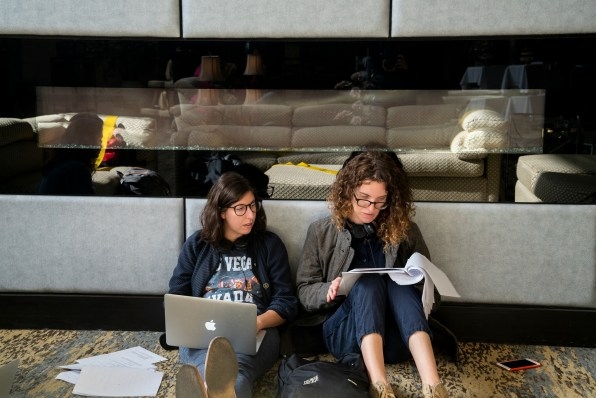
[Photo: Ali Goldstein/Netflix]
The theater season
Part of what the creators wanted to explore with Las Vegas, was the transition from the characters creating TV to performing the same live show every night, night after night. Since both Mensch and Flahive come from a theater background, having previously spent almost a dozen years as working playwrights in New York, they consider this their “theater season.”
“Theater is a pretty natural stepping stone for TV, but putting on a show is a little different,” Mensch says. “There are parts of it that we love so much, but there are parts of it that are infuriating. The idea of our girls being at a casino, doing the same show over and over, felt like a sneaky way to get closer to our roots rather than further away, and lean into the idea of the toll live performance takes on your body and the toll it takes on your soul.”
“These characters repeating the same literal steps and lines every night was exciting for us,” Flahive adds.
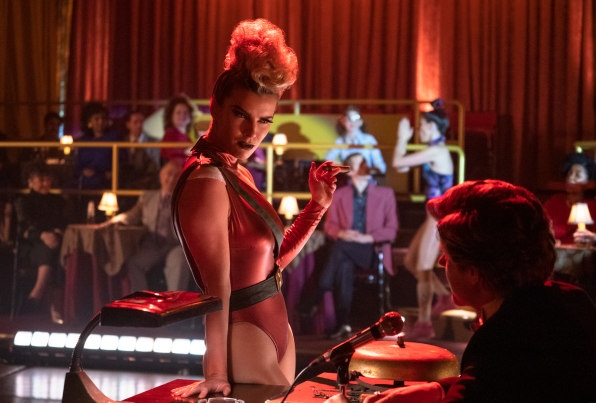
[Photo: Ali Goldstein/Netflix]
Wrestling with less wrestling
Any fans watching the show exclusively for perfectly executed suplexes may be a little disappointed in season three. The creators purposely withhold any glimpses of the actual stage show the G.L.O.W. crew is performing for the first several episodes. The reason? Well, it all goes back to season three being the theater season.
“What we really wanted to show was the repetition, and how that would wear on people,” Flahive says. “But in order for that story to really emotionally land, we had to be there for some time first. So we took the first few episodes pretty slow to kind of settle into Vegas, have some time pass by before we start having the girls react to that repetition with [redacted to avoid a spoiler about the first glimpse of wrestling in the season].”
Having a TV series set within the world of wrestling not depict any wrestling for several episodes is a testament to how textured the characters have become. Their existence outside of the ring by now has become more exciting than ever. Besides, the wrestling scenes tend to pop more when used sparingly.
“We don’t want to exhaust our audience on the wrestling,” Mensch says. “It should mean something. It should move the story forward. We never want it to feel perfunctory, otherwise it could just be another workplace comedy that’s set anywhere and we’re very proud of the fact that we’re a show about women doing this extremely athletic and kind of bananas thing that will always be the motor and heart of the show.”
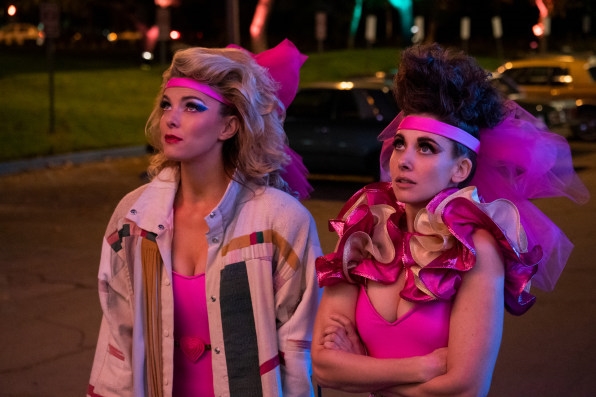
[Photo: Ali Goldstein/Netflix]
Resetting the friendship dynamic
The first-season falling out between Ruth and Debbie is the kind from which friendships seldom recover. (Debbie’s husband cheated on her with long-time confidante Ruth.) Throughout the first two seasons, the pair’s relationship is icily professional at absolute best, but with the change of scenery, viewers get to see them in a new light.
“What Vegas gives us, again, is sort of a Summer Stock unreality, where you escape from your real life for a little bit,” Mensch says. “When you’re living in a hotel, doing the same show night after night, like, do you let go sometimes a little bit more? Do you allow some things to happen that you otherwise wouldn’t have allowed to happen? I think that’s an overarching theme for the characters, and something that was really beneficial to Ruth and Debbie’s relationship. You always feel the tension of what they’re not saying, the tension of their past, but I think the beauty of Vegas is that it allowed us to crack some other things open, which was definitely fun but also challenging because you don’t want to cheapen what they went through and what happened and who they are as characters.”
Adds Flahive: “Getting to see how these women were friends without doing a flashback is what Vegas gave us.”
Reflective craziness
Finally, one last reason to move the show’s action to Las Vegas is perhaps the most obvious: because Las Vegas may just be the only place as big and loud and unreal as the live wrestling show itself.
“In the world of the show, the world inside the ring is Technicolor and over the top and kind of like obnoxiously in your face,” Flahive says. “And in Vegas, that’s kind of reversible; that’s what the city actually is. So in this season, the ring is almost like a quiet respite away from the loud Vegas casino, where they can just go in and do their show.”
Fast Company , Read Full Story
(17)

